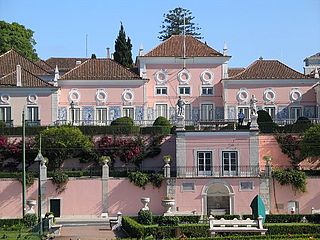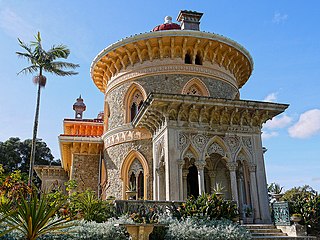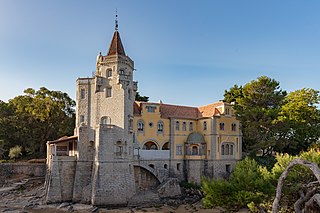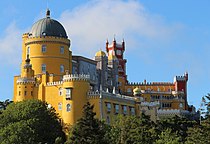
Sintra is a town and municipality in the Greater Lisbon region of Portugal, located on the Portuguese Riviera. The population of the municipality in 2021 was 385,654, in an area of 319.23 square kilometres (123.26 sq mi). Sintra is one of the most urbanized and densely populated municipalities of Portugal. A major tourist destination famed for its picturesqueness, the municipality has several historic palaces, castles, scenic beaches, parks and gardens.

The Estoril Casino is a casino in the Portuguese Riviera, in the municipality of Cascais, Portugal. Today, it is one of the biggest working casinos in Europe.

Cascais is a town and municipality in the Lisbon District of Portugal, located on the Portuguese Riviera. The municipality has a total of 214,158 inhabitants in an area of 97.40 km2. Cascais is an important tourist destination. Its marina hosts events such as the America's Cup and the town of Estoril, part of the Cascais municipality, hosts conferences such as the Horasis Global Meeting.

The Belém Palace, formally the National Palace of Belém,, is the current official residence of the president of the Portuguese Republic, the head of state of Portugal. Located in the Belém District of Lisbon, the palace's main façade fronts the Praça Afonso de Albuquerque, facing the Tagus River. A former residence of the Portuguese royal family, the Belém Palace complex is made up of various buildings, wings, courtyards, and gardens, built variously from the 18th to 21st centuries.

Oeiras is a town and municipality in the western part of Lisbon metropolitan area, located within the Portuguese Riviera, in continental Portugal. The municipality is part of the urban agglomeration of Lisbon and the town of Oeiras is about 16 km from Lisbon downtown. The population in 2011 was 172,120 living in an area of 45.88 km2, making the municipality the fifth-most densely populated in Portugal.
Parede is a former civil parish in the municipality of Cascais, Portugal. In 2013, the parish merged into the new parish Carcavelos e Parede. In 2001 its resident population was approximately 17,830 inhabitants, covering an area of 3.6 km2, west of Lisbon on the coast near the mouth of the Tagus estuary. Parede is a community between the larger towns of Oeiras and Cascais, in the district of Lisbon, along the Linha do Estoril railway line that follows the coast from Lisbon to Estoril and Cascais.

São Domingos de Rana is a civil parish of the Portuguese municipality of Cascais, part of the Greater Lisbon subregion. The population in 2011 was 57,502, in an area of 20.36 km2. The parish includes the localities Abóboda, Cabeço de Mouro, Caparide, Matarraque, Outeiro de Polima, Polima, Rana, Talaíde, Tires, Trajouce and Zambujal.

São Domingos de Benfica is a freguesia and district of Lisbon, the capital of Portugal. Located in northern Lisbon, São Domingos de Benfica is east of Benfica, south of Carnide, west of Alvalade, and north of Campolide. The population in 2011 was 33,043,

Raul Lino was a Portuguese architect, designer, architectural theorist, and writer. Lino's architectural theses and studies revolved around the theory of the Casa Portuguesa, an idealized concept of Portuguese residential architecture, planning, and lifestyle.

Francisco Caldeira CabralGCIH • GOIP was a Portuguese landscape architect. He was an active and internationally reputed landscape architect from the 1940s to the 1980s. He was a pioneer in the practice, study and teaching of Landscape Architecture, and he was a pioneer of the Portuguese environmental movement.

The Portuguese Riviera is a term used in the tourist industry for the affluent coastal region to the west of Lisbon, Portugal, centered on the coastal municipalities of Cascais, Oeiras and Sintra. It is coterminous with the Estoril Coast and occasionally known as the Costa do Sol. Portuguese themselves do not use this expression.

The Palácio dos Condes de Castro Guimarães, originally known as the Torre de São Sebastião, was built in 1900 as an aristocrat’s summer residence in Cascais, Lisbon District, Portugal. It became a museum in 1931. The building follows an eclectic architectural style, while the museum includes paintings of national and international significance, furniture, porcelain, jewellery and a neo-Gothic organ.

The Museum of Portuguese Music is a small museum housed in the Casa Verdades de Faria in Estoril, municipality of Cascais, Portugal, on the Portuguese Riviera. It contains a collection of Portuguese musical instruments and other items, as well as a music documentation centre, and is also used for recitals.

The Palácio dos Condes da Guarda is located in Cascais, Lisbon District, Portugal. The building now functions both as the headquarters of the Municipality of Cascais and, on the ground floor, as a museum that explains the history of the town.

The Exiles Memorial Center was located in Estoril, Portugal and housed a permanent exhibition of photographs, documentation and objects related to the history of refugees who stayed in the Cascais/Estoril area of Portugal during the period between 1936 and 1955. The Memorial Center, inaugurated in February 1999, was situated above the Estoril post office in a building designed by Portuguese architect Adelino Nunes. The building opened in 1942. The main objective of the Memorial Center was to "evoke the memory of one of the most important events in [Portugal's] history: to have represented a place of refuge, waiting and passage of thousands of exiles and refugees in the context of European conflicts" most notably during World War II. The Memorial Center was open to the public until its closure on 24 April 2023 by the city council. It is unknown at this time whether the closure will be permanent or whether the memorial space will be relocated.

The Chalet Ficalho was a summer residence in Cascais in the Lisbon District of Portugal that was built in 1887–1888 for the Viscount of Ovar and his wife, who would later become the Countess of Ficalho. It is one of the finest examples of the so-called summer architecture of the Cascais area. The building is now a hotel.






















